Upland Pine Photo Gallery
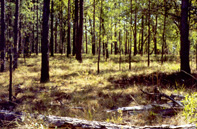 |
Upland Pine Depends on Burning
The upland pine ecosystem depends on frequent fires to exclude competing species. The ecosystem is dominated by longleaf pines and has an open understory with a dense ground cover of grasses and herbs. It includes fire resistant hardwoods such as southern red oak and turkey oak. Historically, the natural fire frequency in upland pine forests was about every 3 to 5 years. These fires usually were started by lightning strikes during summer thunderstorms. |
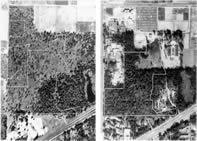 |
What Happens When Fires are Excluded
If fire is excluded, laurel oaks and other fire-susceptible hardwoods become dominanat. The aerial photograph on the left, made in 1949, shows a clear demarkation between historically burned and unburned areas. Wetter soils protected the hammock (lower right of NATL's outline) from the fires that maintained the upland pine. By 1990 (aerial photo on right), exclusion of fire had allowed laurel oaks to spread throughout the upland pine. |
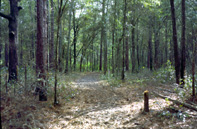 |
Dense Growth of Laurel Oaks Keeps Pines from Reproducing
NATL's upland pine now lacked the exposed mineral soil required for seeds of longleaf pine to germinate and the abundant light at ground level required for the seedlings to survive and grow. (1995 photo)
|
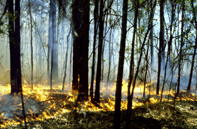 |
Prescribed Burn Helps Restore NATL's Upland Pine (1996)
This prescribed burn (and five others by 2004) helped rid NATL's upland pine ecosystem of laurel oaks and other species that had invaded during the more than 50 years of fire exclusion. |
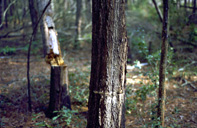 |
Girdled Laurel Oaks
Although repeated fires would have eventually killed the laurel oaks, starting in 1997, many
were girdled to speed the restoration of the upland pine ecosystem. Girdling involves cutting the phloem and cambiam layers and prevents food manufactured in the leaves from reaching the roots. |
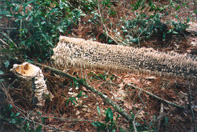 |
Effects of Girdling
In addition to starving the roots, girdling allows fungi to enter and weaken
the xylem (wood). Many of the girdled laurel oaks blew down before other symptoms
appeared. |
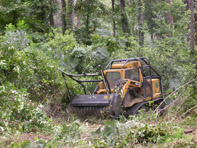 |
Mulching the Undergrowth
In some areas, burning could not be done soon after the laurel oaks were downed. In June 2003, the Division of Forestry's Wildland-Urban Interface fuel reduction team used its heavy equipment to mulch the undergrowth and most of the logs and stumps left from cutting and girdling the laurel oaks. This made possible a safe, effective prescribed burn in February 2004. |
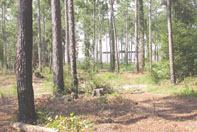 |
Nearly Restored
In 2003, after four prescribed burns, the upland pine ecosystem in NATL's public area once more had exposed mineral soil and lots of light reaching ground level--as required for longleaf pine seed germination and seedling survival.
|
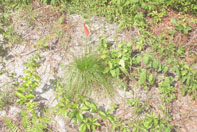 |
Volunteers plant small pines
In June 2003, to hasten the restoration, two volunteers planted this young longleaf pine and 247 others in the upland pine in NATL's public area. The transplant looks like a clump of grass but at its center is a fire-resistant bud.
|
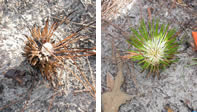 |
Transplants survive burning
A prescribed burn in February 2004 burned away the needles of the transplanted longleaf pines, but their fire-resistant central buds allowed nearly all to survive. However, by that fall, only about 10% of the 248 originally transplanted still survived. Sawflies may have accounted for much of the mortality (see below).
|
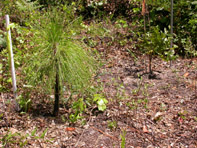 |
A survivor
This pine, which is beginning to "shoot up" in the summer of 2005, is one of the few surviving transplants from 2003. It has survived two controlled burns and unidentified mortality agents that killed most of its companions between spring and early winter 2004. In the right background is a small turkey oak transplanted in the summer of 2004.
|
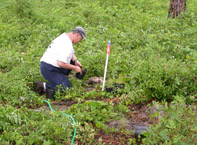 |
Volunteers plant wire grass
Wire grass is the dominant grass in upland pine and its presence helps sustain the fires on which the ecosystem depends. All wire grass had been shaded out when restoration of NATL's upland pine began. In 1997, the Entomology and Nematology Student Organization planted 330 wire grass plugs. In 2004, Ken Prestwich (pictured) helped plant 295 pots of wire grass in NATL's upland pine ecosystem.
|
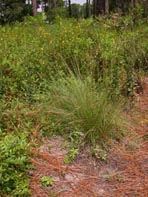 |
Wire grass blooms in NATL
Wire grass is most likely to bloom and set seed after a late spring or early summer burn. This clump, which grew from one of the plugs planted in 1997, is blooming in early September 2005 after a control burn on 14 April 2005.
|
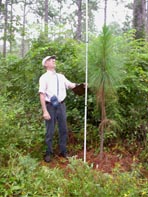 |
Larger pines planted
In July 2004, a volunteer planted 52 longleaf pines, supplied by the Physical Plant Divison, that were 5 to 7 ft. high. All were put near the trails in NATL's public area, to illustrate a growth stage of longleaf pine growth that would otherwise not be seen for another ten years. Here Tom Walker measures one of the 33 transplants that survived the first 14 months.
|
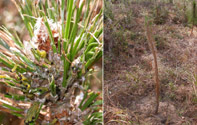 |
Some transplanted pines succumb to sawflies
About one-quarter of the transplanted larger pines died during the first year. Pine sawfly larvae (left photo) apparently caused most of the mortality. The tree in the foreground (right photo) was defoliated by these insects and later died, whereas the tree in the right background of the same picture was untouched and still thrives.
|
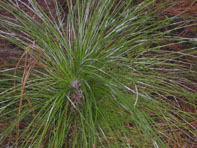 |
Woolly pineneedle aphids stress transplants
Woolly pineneedle aphids sometimes form linear colonies on the needles of longleaf pine where they stress the plant by sucking its sap. These are on a grass-stage transplant that is beginning to shoot up.
|
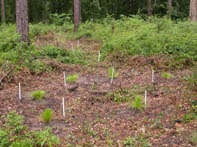 |
More pines planted
In early summer 2005, two volunteers planted 288 grass-stage and ready-to-shoot longleaf pines in NATL's public area upland pine ecosystem. To make it easy to track the health of the transplants and to treat any problems detected, these were planted in 48 groups of six in manually cleared, mapped areas and individually staked. [The six pines in the foreground constitute Group #33.]
|
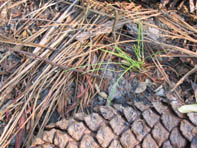 |
Natural reproduction begins anew
On 20 June 2005, volunteer Ken Prestwich detected this and two other naturally germinated longleaf pine seedlings in the north public-area upland pine. This was the first such longleaf pine recruitment in NATL's upland pine in more than 40 years. Note the charcoal from the 14 April 2005 controlled burn. That burn left mineral soil exposed, on which the germination occurred.
|
More on the upland pine ecosystem and its management.
More photos: Semi-annual photos of Public and Restricted Area Pines, 2007-date.

